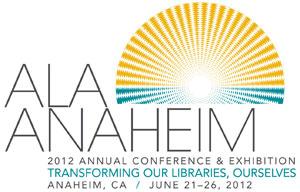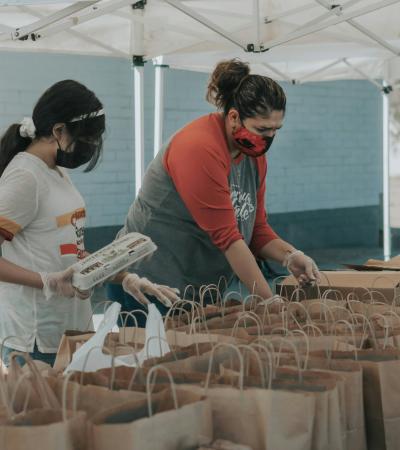It’s no shocking secret that libraries and librarians are information providers—it’s the foundation upon which libraries are built, and information sources (aka books) are generally the first thing most people think about when they hear the word “library.” However, depending on how often a patron uses a library, civic engagement might not be near the top of the list if he or she were to write down all of the things the local library does.

At today’s ALA session, “Libraries at the Crossroads: Programming for Civic Engagement,” four librarians from a wide variety of backgrounds discussed why civic engagement isn’t always an evident role for the library and why (and a little bit about how!) we need to and can work to change this. It makes perfect sense for a library to promote civic engagement: they have neutral, “safe” spaces for discourse, employ people whose missions are to protect information freedom, and have access to resources that can promote healthy forum discussion.
Perhaps it’s because I’m halfway through my MLIS degree at the University of Illinois at Urbana-Champaign that the issue of civic engagement and a library’s place in community building are fresh in my mind. Almost all of my courses have found ways to incorporate overarching themes about issues librarians face today—and civic engagement is definitely one of them. I’d be fibbing if I said this was something I’d given much, if any, thought to before starting my program, though. Even as an avid, life-long library patron, I hadn’t really considered the importance of the library as not only a space for discourse to occur (though that’s certainly a terrific first step), but also as an organization that has a responsibility to support public discourse with resources, moderators, and information on the issues being discussed.
Part of this role, as discussed by Rutgers University librarian Nancy Kranich, is to help shift from an informed citizen model of service to an engaged, strong-democracy model. This shift in thinking naturally goes hand-in-hand with the “information overload” patrons can face today, along with some core values of information literacy: now that the patrons have the information, we need to help them engage with it.
Tricia Suellentrop (Johnson County Public Library in Kansas), Chad Kahl (Illinois State University), and Nicole Sump-Crethar (Oklahoma State University) described many of the ways their respective libraries are engaging patrons in civic discourse. On the onset, this type of programming may seem better suited to a public library (as most programming tends to seem), but in fact, the academic libraries are also making strides in incorporating both their students and their communities as well. (As a personal aside, I was quite pleased to hear about the academic libraries’ efforts to promote civic engagement. I am a graduate assistant in U of I’s Undergraduate Library, so my experience—and in turn, my interests—tend to skew to the academic side of things. But I have taken two courses in U of I’s Community Informatics concentration and have immensely enjoyed working with community groups akin to those public libraries would normally reach out, and I’m happy that there may be opportunities to find a happy medium between the two in my future.)
The civic engagement programs these libraries are providing cover a wide range of interested and issues, obviously tailored to their unique communities and to events that affect their patrons. Sometimes they get involved in national-level initiatives (American Democracy Project), and other times it is very community-specific (the Johnson County library hosted a Frost-Nixon forum after the local theater group performed the play, and Illinois State University has opportunities specifically for their students who are completing the Community Engagement minor).
And while I loved hearing about all of the programming ideas, successes, and occasional road bumps that hosting these types of events can bring, the idea that most struck me came from Suellentrop, and her dedication to bringing civic engagement not only to her patrons, but to the library staff. Located in the Kansas City suburban metro area (on the Kansas side of city), the Johnson County system has thirteen branches and nearly 450,000 people to serve. Like many libraries, Johnson County has been hit with severe budget cuts and was faced with cutting their programming opportunities by more than half (from about fifty events a year to twenty). Instead of one committee or group of board members or a library director making the decision, the programs to be offered and the overall programming philosophy were debated in several rounds by many staff members, board members, and administrators, first in larger groups, and then smaller and smaller—each round forcing people to discuss, debate, consolidate, and compromise—until a list of twenty programs and a solid philosophy had been established. And while nearly every department felt the effects of the cuts, Suellentrop talked about the ownership the staff felt over the final decision, as everyone had an opportunity to articulate their opinions and the importance of their individual programming areas. The library, as a result, was thus wholly stronger at the end of what sounded like at times a painful process. The Johnson County example is a lovely microcosm of how civic engagement should work on a community level.
Applying civic engagement tactics to the internal infrastructure of your library could accomplish many things: staff members developing a better understanding of how forums and proactive discussion take place; boosting library staff “buy-in” for supporting public engagement programming; increasing resources dedicated to training librarians and staff members to become moderators for public forums and purchasing/creating issue guides; and strengthening the library’s role of promoting democracy within its community, just to name a few.
I won’t pretend that there aren’t plenty of obstacles to establishing successful civic engagement programming (probably even more than I can understand at this time, still being a student). Getting people interested—from patrons to city council members to library boards to government officials—all takes time, resources, and a whole lot of elevator speeches. But as someone who’s just preparing to embark on a (second) career, I take great comfort in knowing that librarians are actively adapting to new roles when it comes to public discourse. It’s no longer enough to simply have access to information; we must also be facilitators, champions of engagement, and proponents of the library as a neutral meeting space to aid in our fight for continued relevancy in the information overload age.



